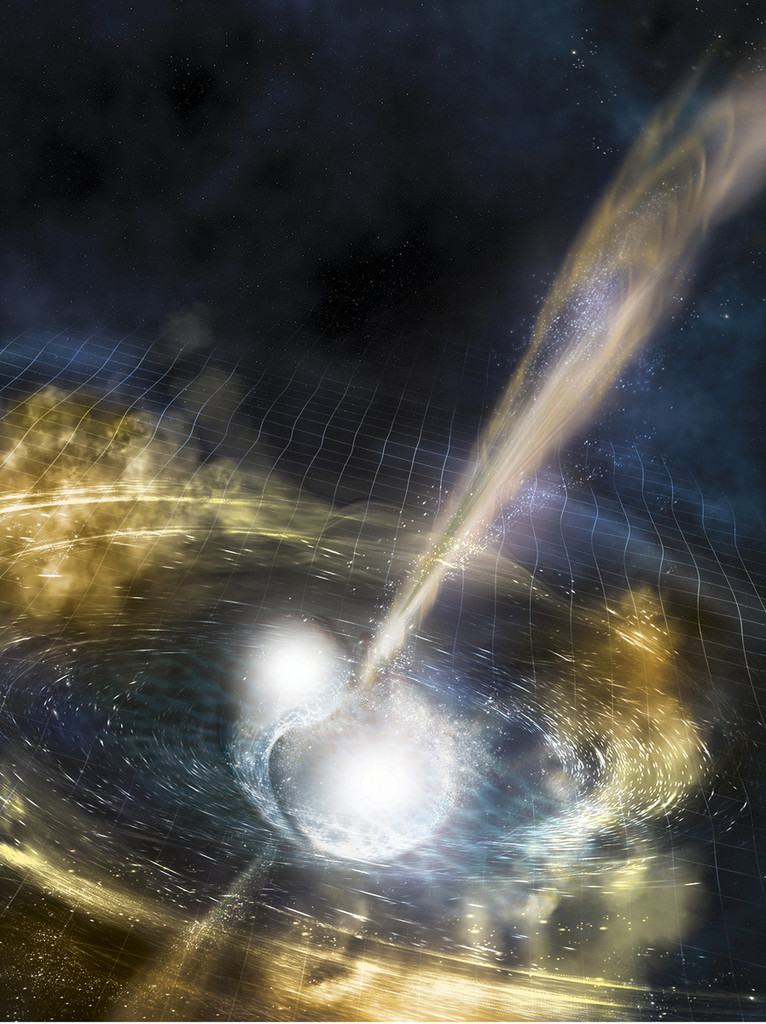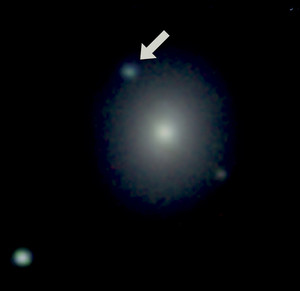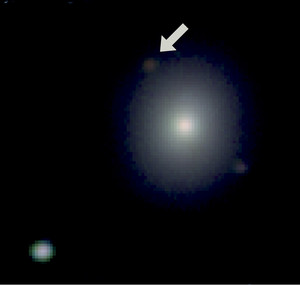
NSF / LIGO / SONOMA STATE UNIVERSITY / A. SIMONNET
Artistic representation of two neutron stars colliding, as detected on August 17, 2017NSF / LIGO / SONOMA STATE UNIVERSITY / A. SIMONNETAugust 17, 2017 will go down in astronomy history as the day when computers at a Hanford laboratory, on the West Coast of the United States, recorded the passage of another gravitational wave through Earth. This small former town in Washington State, where radioactive material was produced for the atomic bomb used in Nagasaki, Japan, is home to one of the most accurate instruments ever built to measure variations in distance: a laser interferometer designed to detect the subtle deformations in space-time caused by gravitational waves. A fraction of a second before the Hanford lab detected this gravitational wave, an identical instrument in Livingston, Louisiana, identified the same signal. The disturbance recorded by these twin laboratories, both run by the Laser Interferometer Gravitational-Wave Observatory (LIGO), was also recorded almost simultaneously by a similar device—the Virgo interferometer—in Pisa, Italy.
For one minute and forty seconds, the three detectors observed the final stages of the collision and death of two fading stars. Guided by gravity, the two neutron stars—the smallest and densest known star types—orbited around each other, losing energy to space in the form of gravitational waves as they moved ever closer to one another. Finally, they collided, causing an explosive event called a kilonova, which occurred 130 million light years from Earth on the outskirts of galaxy NGC 4993, in the Hydra constellation. The mass of the two stars was only slightly greater than the Sun’s, and at 12 kilometers in diameter, they were invisible to our telescopes. As they collided, they released a cloud of incandescent matter that for a fraction of a second shone brighter than all the stars in the Milky Way. After detecting the gravitational waves and locating the area of space from which they came, ground and space telescopes recorded the wave of light emitted by the kilonova, allowing researchers to study the matter launched into space by the explosion.
“This is the first time that we’ve observed a cataclysmic astrophysical event in both gravitational waves and electromagnetic waves,” said physicist David Reitze in the official announcement of the discovery, made on October 16 at the headquarters of the National Science Foundation, USA. Reitze is executive director of the Laser Interferometer Gravitational-Wave Observatory (LIGO), a scientific collaboration involving more than 1,200 researchers, including some in Brazil, who operate the two detectors on North American soil.
He believes that the detection of gravitational and electromagnetic waves emitted by a single phenomenon will open the door to the era of multimessenger astronomy. The two wave types provide different information about celestial objects: while gravitational waves are generated by oscillating matter that disrupts space-time, electromagnetic waves are produced by vibrations of electrically charged particles and are perceived as visible and invisible light. Both travel through empty space at 300,000 kilometers per second, and together they can reveal the characteristics of the object that created them.

1M2H/UC SANTA CRUZ AND CARNEGIE OBSERVATORIES
The arrow indicates the region of galaxy NGC 4993 where the neutron star collision occurred, as seen on August 17…1M2H/UC SANTA CRUZ AND CARNEGIE OBSERVATORIESUnknown state
For decades, astronomers have observed the light—especially radio waves and X-rays—emitted by the outer layers of neutron stars. This light can help us to understand the surface of the stars, but it reveals little about their interior. Physicists and astrophysicists believe that the deeper layers are subjected to such high density and pressure that matter there would assume an unknown state. The solution to this mystery could be found in the gravitational waves generated by the collision of two neutron stars, since the resulting ripples in space-time depend to some extent on how the matter inside the stars deforms and fractures during the collision.
Observing collisions between stars of this type could become routine in the coming years due to improvements to the LIGO and Virgo detectors, which are both scheduled for maintenance and upgrades. The LIGO observatory, for example, completed its second data collection period on August 25, and is due to return to operations in October 2018 with greater sensitivity. At the same time, researchers are hoping to halve the noise that affects the operation of the instruments. “We may observe as many as five to ten times more collisions involving black holes and neutron stars,” says Italian physicist Riccardo Sturani, from the International Institute of Physics at the Federal University of Rio Grande do Norte (IIP-UFRN), which performs analytical calculations on the gravitational waves that LIGO records. Sturani is part of the LIGO team working to improve the accuracy of the detectors, alongside Odylio Aguiar and César Costa, both from the Brazilian National Institute for Space Research (INPE).
The first direct observation of gravitational waves in September 2015 confirmed a phenomenon predicted by Albert Einstein’s theory of general relativity, formulated in 1915, in which Einstein modified the law of universal gravitation proposed by Isaac Newton in 1687. Newton described gravity as an attractive force produced by the mass of a physical body. Einstein reformulated the idea of gravitational force, space, and time in his theory of general relativity, stating that both the mass and the energy of a body produce gravitational force, which manifests as the curvature of space and slowing of time around a body. The greater the mass and the energy of the body, the greater the gravitational force and distortion in space and time, described as a single entity called space-time. One consequence is that the movement of bodies produces ripples in space-time that propagate as gravitational waves.
Severe distortions in space-time occur, for example, when a star with a huge mass consumes all of its nuclear fuel and its core collapses, creating a black hole—where gravity is so high that not even light can escape it—or a neutron star, the smallest and densest known type of star. Both cases result in an extreme curvature of space-time, with any remaining matter subjected to intense pressure and density.
The mass of a neutron star is about 1.4 times the mass of the Sun, but its diameter is only about 20 kilometers—roughly 70,000 times smaller than the Sun. “A lump of neutron star matter the size of a sugar cube on Earth would weigh as much as all the humans on the planet,” says Jorge Horvath, a specialist in these ultracompact stars from the Institute of Astronomy, Geophysics, and Atmospheric Sciences at the University of São Paulo (IAG-USP).
According to Horvath, neutron stars have a crust that is a few hundred meters thick and composed of heavy chemical elements such as iron. Somewhere between 800–900 meters below the crust, the density becomes so high that the negatively charged particles (electrons) at the edges of the atoms are crushed against the positively charged particles (protons) of the atomic nucleus. As a result, they cancel each other out, creating neutral particles known as neutrons, which remain squeezed against each other. In deeper areas, the density increases even further and the composition of the superdense matter is not known. “The central core of a neutron star is a mystery,” says Horvath.
Several theoretical models have attempted to predict what the inside of these stars would look like. They differ in how the density of the matter varies under the pressure—this relationship between density and pressure is defined by a mathematical formula called an equation of state. “Scientists will almost certainly be able to determine the equation of state of neutron stars within the next few decades, thanks to improvements in the observation of X-ray emissions and the detection of more gravitational waves,” says physicist Raissa Mendes, a professor at the Fluminense Federal University (UFF).

1M2H/UC SANTA CRUZ AND CARNEGIE OBSERVATORIES
…and August 211M2H/UC SANTA CRUZ AND CARNEGIE OBSERVATORIESWave of discoveries
Einstein predicted the existence of gravitational waves in 1916, but it was only in the 1950s that physicists were convinced that if general relativity was correct, certain bodies in accelerated motion would lose some of their energy into empty space in the form of gravitational waves. However, calculations suggested that these waves would be weak. Instruments on earth would only be capable of observing gravitational waves emitted by bodies with very large masses and energy densities, accelerating at close to the speed of light.
In the 1970s, a small group of physicists grew enthusiastic about the challenge of detecting these waves. Rainer Weiss, from the Massachusetts Institute of Technology (MIT), USA, was one of the first to come up with the idea for the detectors that would eventually become the LIGO observatory. The theoretical works of Kip Thorne, from the California Institute of Technology (Caltech), and his colleagues showed that such a detector could record the gravitational waves emitted by the collision of black holes and neutron stars in distant galaxies. Barry Barish, also from Caltech, was instrumental in organizing the international scientific collaboration at the LIGO after construction of the detectors was approved in the 1990s. This year’s Nobel Prize in Physics recognized all three for their roles in creating the LIGO, which began operations in 2002 and since September 2015 has observed the gravitational waves produced by the collisions of four pairs of black holes; events that do not emit light.
Collisions involving neutron stars, like the one detected in August, are different. In the 1990s, researchers suggested that such an event could be the source of the mysterious gamma-ray bursts (GRBs) observed by satellites since the 1960s.
Gamma-ray bursts
According to the theory of general relativity, the immense gravitational force of two merging stars would attract the surrounding matter, forming a kind of vortex. This matter, spiraling at close to the speed of light, would produce a jet at each magnetic pole of the vortex, launching electrically charged particles vast distances into space. This jet would last for fractions of a second and would generate the short gamma-ray bursts detected on Earth.
On August 17, less than two seconds after the LIGO and Virgo gravitational wave observations, NASA’s Fermi Space Telescope recorded a gamma-ray burst from the same area of space, proving Einstein’s theory (see article).
A few hours later, ground and space telescopes searched the region and identified the emergence of a light source and other electromagnetic waves at the edge of galaxy NGC 4993. The researchers believe that this light was emitted by some of the star matter that was thrown into space instead of being sucked into the vortex. This violent explosion, called a kilonova, produced chemicals heavier than iron (see article). Over the following days, the observatories watched the brightness of the kilonova diminish and change color, emitting visible, infrared, and ultraviolet light.
“Radio waves emitted by the merging of these stars are still being observed,” explains Jessica McIver, a physicist from Caltech and coordinator of a team at the LIGO. “The coincident observation of gravitational waves and gamma-ray bursts confirms the hypothesis proposed decades ago that short gamma-ray bursts are produced when neutron stars merge. The gravitational waves, short gamma-ray bursts, and the kilonova give us a complete picture of the matter ejected from the collision and merging of neutron stars.”
LIGO researchers also used gravitational waves recorded in August to obtain information about the relationship between density and pressure inside neutron stars. This information can be enhanced by future observations, such as the collision of a black hole with a neutron star. “A black hole would induce an even stronger tidal force that may tell us more about the compactness of neutron stars,” predicts McIver. Additional observations should help us to understand how uniform the composition of neutron stars is and to calculate the quantity of heavy chemical elements ejected into space. “We might then know how close our planet needed to be to a neutron star merger to have the density of gold we see on Earth,” she explains.
Scientific articles
ABBOTT, B. P. et al. Multi-messenger observations of a binary neutron star merger. The Astrophysical Journal Letters. V. 848, No. 2. Oct. 16, 2017.
ABBOTT, B. P. et al. Observation of gravitational waves from a binary neutron star inspiral. Physical Review Letters. V. 119, 161101. Oct. 16, 2017.